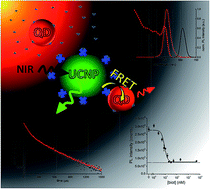Upconverting nanoparticle to quantum dot FRET for homogeneous double-nano biosensors†
Abstract
Both upconverting nanoparticles (UCNPs) and semiconductor quantum dots (QDs) have revolutionized optical biosensing because of their unique photophysical properties. However, their outstanding photostability, near-infrared (NIR) excitability, and colour tunability have never been combined for homogeneous mix-and-measure FRET (Förster resonance energy transfer) biosensors that do not require any washing or separation steps. Here we demonstrate that UCNP-to-QD FRET systems can be used for rapid homogeneous bioassays, which are essential tools for clinical diagnostics. One of the main drawbacks of UCNPs for FRET, namely their very low photoluminescence (PL) quantum yields, was efficiently overcome by using QD FRET acceptors with very strong spectral overlap with the UCNP donors. This resulted in unrivalled Förster distances for UCNP-based FRET pairs of up to 6 nm. We could quantify the prototypical analyte biotin (vitamin H) at low nanomolar concentrations and steady-state and time-resolved PL analysis showed that UCNP-to-QD FRET was caused by streptavidin-to-biotin binding. Immediate applicability in biosensing was demonstrated by biotin replacement assays over a large concentration range with IC50 values between 8 nM and 250 nM and detection limits down to 5 nM. The high photostability of the double-nanoparticle biosensor, the NIR excitation of UCNPs for minimal autofluorescence, and the spectral multiplexing capability of QDs offer a large potential for spectroscopy and imaging-based biosensing beyond in vitro diagnostics.


 Please wait while we load your content...
Please wait while we load your content...